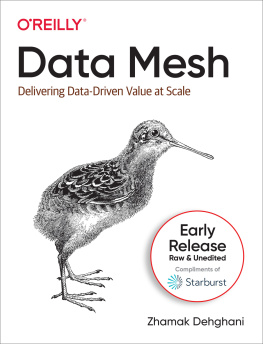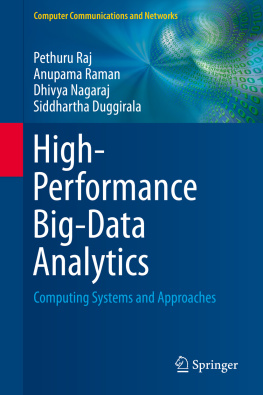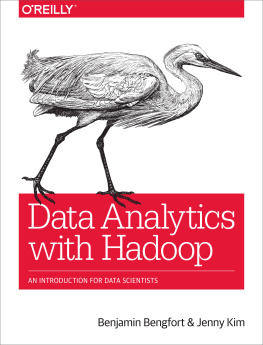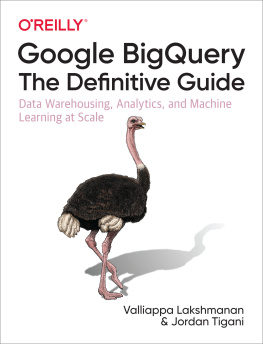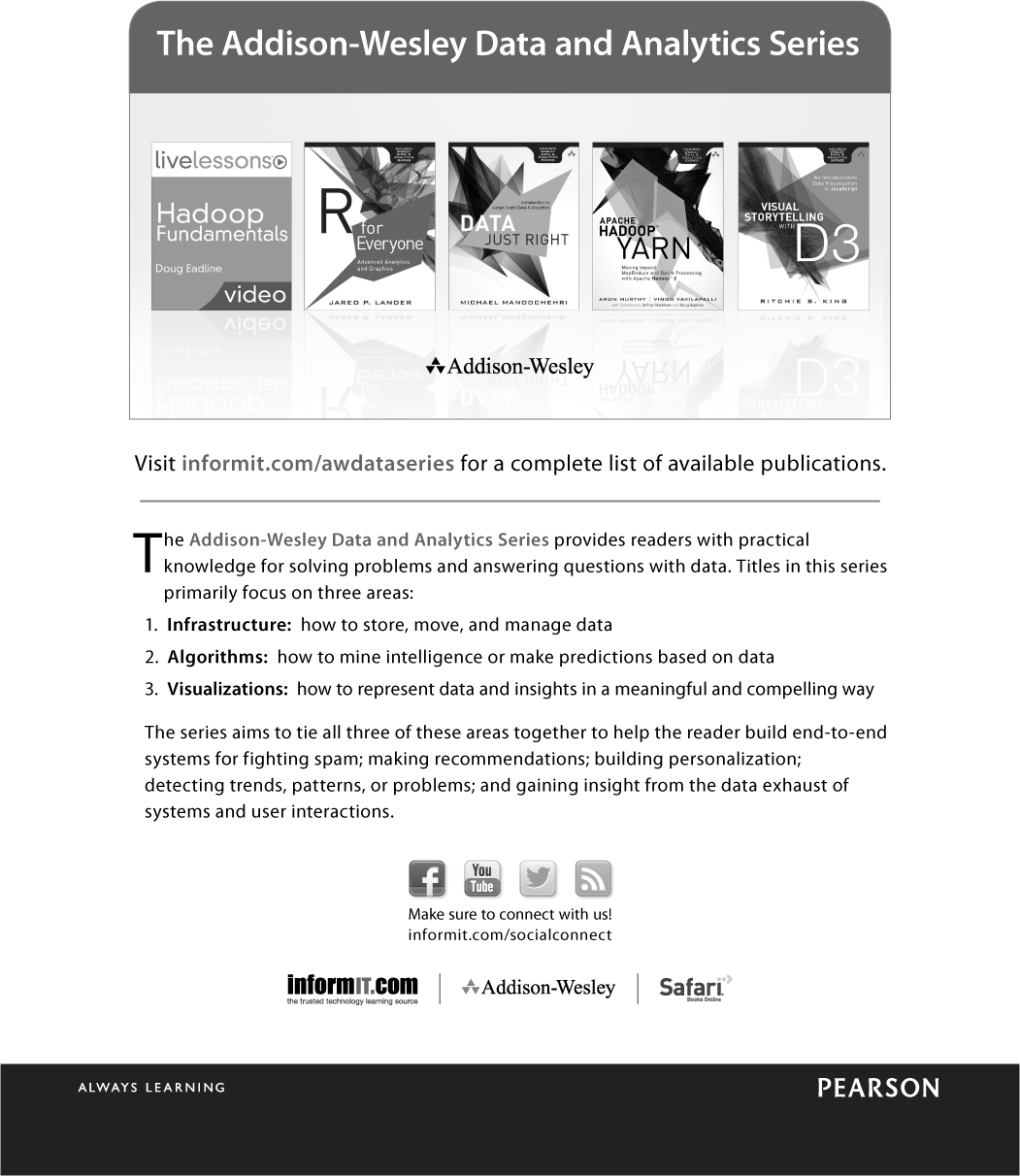About This eBook
ePUB is an open, industry-standard format for eBooks. However, support of ePUB and its many features varies across reading devices and applications. Use your device or app settings to customize the presentation to your liking. Settings that you can customize often include font, font size, single or double column, landscape or portrait mode, and figures that you can click or tap to enlarge. For additional information about the settings and features on your reading device or app, visit the device manufacturers Web site.
Many titles include programming code or configuration examples. To optimize the presentation of these elements, view the eBook in single-column, landscape mode and adjust the font size to the smallest setting. In addition to presenting code and configurations in the reflowable text format, we have included images of the code that mimic the presentation found in the print book; therefore, where the reflowable format may compromise the presentation of the code listing, you will see a Click here to view code image link. Click the link to view the print-fidelity code image. To return to the previous page viewed, click the Back button on your device or app.
Data Just Right
Introduction to Large-Scale Data & Analytics
Michael Manoochehri

Upper Saddle River, NJ Boston Indianapolis San Francisco
New York Toronto Montreal London Munich Paris Madrid
Capetown Sydney Tokyo Singapore Mexico City
Many of the designations used by manufacturers and sellers to distinguish their products are claimed as trademarks. Where those designations appear in this book, and the publisher was aware of a trademark claim, the designations have been printed with initial capital letters or in all capitals.
The author and publisher have taken care in the preparation of this book, but make no expressed or implied warranty of any kind and assume no responsibility for errors or omissions. No liability is assumed for incidental or consequential damages in connection with or arising out of the use of the information or programs contained herein.
For information about buying this title in bulk quantities, or for special sales opportunities (which may include electronic versions; custom cover designs; and content particular to your business, training goals, marketing focus, or branding interests), please contact our corporate sales department at or (800) 382-3419.
For government sales inquiries, please contact .
For questions about sales outside the United States, please contact .
Visit us on the Web: informit.com/aw
Library of Congress Cataloging-in-Publication Data
Manoochehri, Michael.
Data just right : introduction to large-scale data & analytics / Michael Manoochehri.
pages cm
Includes bibliographical references and index.
ISBN 978-0-321-89865-4 (pbk. : alk. paper)ISBN 0-321-89865-6 (pbk. : alk. paper)
1. Database design. 2. Big data. I. Title.
QA76.9.D26M376 2014
005.743dc23
2013041476
Copyright 2014 Pearson Education, Inc.
All rights reserved. Printed in the United States of America. This publication is protected by copyright, and permission must be obtained from the publisher prior to any prohibited reproduction, storage in a retrieval system, or transmission in any form or by any means, electronic, mechanical, photocopying, recording, or likewise. To obtain permission to use material from this work, please submit a written request to Pearson Education, Inc., Permissions Department, One Lake Street, Upper Saddle River, New Jersey 07458, or you may fax your request to (201) 236-3290.
ISBN-13: 978-0-321-89865-4
ISBN-10: 0-321-89865-6
Text printed in the United States on recycled paper at RR Donnelley in Crawfordsville, Indiana.
First printing, December 2013
This book is dedicated to my parents,
Andrew and Cecelia Manoochehri,
who put everything they had into making sure
that I received an amazing education.
Foreword
The array of tools for collecting, storing, and gaining insight from data is huge and getting bigger every day. For people entering the field, that means digging through hundreds of Web sites and dozens of books to get the basics of working with data at scale. Thats why this book is a great addition to the Addison-Wesley Data & Analytics series; it provides a broad overview of tools, techniques, and helpful tips for building large data analysis systems.
Michael is the perfect author to provide this introduction to Big Data analytics. He worked on the Cloud Platform Developer Relations team at Google, helping developers with BigQuery, Googles hosted platform for analyzing terabytes of data quickly. He brings his breadth of experience to this book, providing practical guidance for anyone looking to start working with Big Data or anyone looking for additional tips, tricks, and tools.
The introductory chapters start with guidelines for success with Big Data systems and introductions to NoSQL, distributed computing, and the CAP theorem. An introduction to analytics at scale using Hadoop and Hive is followed by coverage of real-time analytics with BigQuery. More advanced topics include MapReduce pipelines, Pig and Cascading, and machine learning with Mahout. Finally, youll see examples of how to blend Python and R into a working Big Data tool chain. Throughout all of this material are examples that help you work with and learn the tools. All of this combines to create a perfect book to read for picking up a broad understanding of Big Data analytics.
Paul Dix, Series Editor
Preface
Did you notice? Weve recently crossed a threshold beyond which mobile technology and social media are generating datasets larger than humans can comprehend. Large-scale data analysis has suddenly become magic.
The growing fields of distributed and cloud computing are rapidly evolving to analyze and process this data. An incredible rate of technological change has turned commonly accepted ideas about how to approach data challenges upside down, forcing companies interested in keeping pace to evaluate a daunting collection of sometimes contradictory technologies.
Relational databases, long the drivers of business-intelligence applications, are now being joined by radical NoSQL open-source upstarts, and features from both are appearing in new, hybrid database solutions. The advantages of Web-based computing are driving the progress of massive-scale data storage from bespoke data centers toward scalable infrastructure as a service. Of course, projects based on the open-source Hadoop ecosystem are providing regular developers access to data technology that has previously been only available to cloud-computing giants such as Amazon and Google.
The aggregate result of this technological innovation is often referred to as Big Data. Much has been made about the meaning of this term. Is Big Data a new trend, or is it an application of ideas that have been around a long time? Does Big Data literally mean lots of data, or does it refer to the process of approaching the value of data in a new way? George Dyson, the historian of science, summed up the phenomena well when he said that Big Data exists when the cost of throwing away data is more than the machine cost. In other words, we have Big Data when the value of the data itself exceeds that of the computing power needed to collect and process it.



